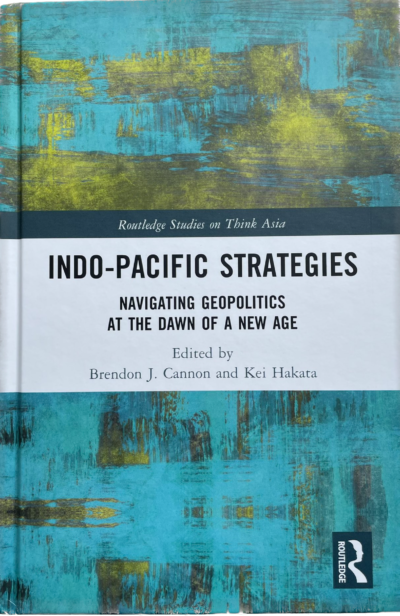Brendon J. Cannon, Kei Hakata, Abingdon (eds.) (2022), “Indo-Pacific Strategies: Navigating Geopolitics at the Dawn of a New Age, London: Routledge.
Sharmistha Hazra
 Asia’s resurgence in global politics and the rise of the Indo-Pacific as a new theatre of geopolitics indicates the dawn of a new era in world politics. With the reorientation of America’s Pacific strategy and China’s assertions in the South China Sea, Indo-Pacific has become the fulcrum of an unfolding world order. Written against the backdrop of the US-China competition in the Indian and Pacific Oceans, the edited volume under review attempts to put the ideas of Indo-Pacific in the context of international politics. It brings together research works on the Indo-Pacific, and the geopolitical interplay and the policies of the major stakeholders. The Foreword by the chief architect of the Indo-Pacific concept, the former Japanese Prime Minister Shinzo Abe, sets the tone for the volume by underlying the centrality of the region for the future of humanity.
Asia’s resurgence in global politics and the rise of the Indo-Pacific as a new theatre of geopolitics indicates the dawn of a new era in world politics. With the reorientation of America’s Pacific strategy and China’s assertions in the South China Sea, Indo-Pacific has become the fulcrum of an unfolding world order. Written against the backdrop of the US-China competition in the Indian and Pacific Oceans, the edited volume under review attempts to put the ideas of Indo-Pacific in the context of international politics. It brings together research works on the Indo-Pacific, and the geopolitical interplay and the policies of the major stakeholders. The Foreword by the chief architect of the Indo-Pacific concept, the former Japanese Prime Minister Shinzo Abe, sets the tone for the volume by underlying the centrality of the region for the future of humanity.
Indo-Pacific is not only an emerging geography, but simultaneously, is an idea, a social construct, a zone of connectivity, where the four lynchpin states United States, India, Japan, and Australia, share the importance of countering the emergence of China which is breaking the rule-based order. The policy practitioners can use geopolitics as an essential lens to design the future policies of the Indo-Pacific. Australia has joined Indo-Pacific club to secure itself from the Great power politics of US and China. Another player, India wants to curb China’s activities on the high seas for an open and inclusive Indo-pacific. Japan has promoted the Indo-Pacific strategy to counter China in its neighborhood and to maintain peace and prosperity in the region. As an external power, United States strategic presence could be seen throughout the region, but fails to check China's rise.
As a response to the Indo-Pacific strategy, China has changed its foreign policy from “hide one’s capacity” to “strive for achievement” and has acted as an assertive power in the Indo-Pacific. ASEAN has failed to find a singular strategy for the Indo-Pacific as it is facing challenges both from the United States and China. Small Island states (SISs) like Sri Lanka, Seychelles, Tango and others are following “friends to all, enemies to none” rule to benefit from both United States and China. In fact, a big multilateral forum like European Union has failed to find a common strategy for global stability in the case of the Indo-Pacific. The Gulf states, on the other hand, have played the hedging strategy to keep the US as the security provider, nonetheless inviting Chinese investments. Despite huge investment in countries like Kenya and Tanzania, there are serious anti-China slogan in those states which the lynchpin states could use to increase their influence.
Geopolitics at the Dawn of a New Age (2022) lies in the fact that despite taking a subject on which a dozen of books have been published on, however, this one has been able to explore the policies of the four lynchpins states along with China and another important player like the EU and a small player like Sri Lanka. While most books (on this matter? China’s foreign policy?) only talk about how to counter China, this one has tried to give a fair picture of China’s foreign and domestic policy. (Noun: author, editor) analyzes the theories first and then explains (maybe use: expands on) the ground realities has helped to understand the ongoing geopolitical rivalries in Indo-Pacific. It has unfolded some areas of research on Indo-Pacific strategics and has suggested that the Indo-Pacific will be the future area for great power politics. The policies and the suggestions from the book has made to maintain peace and prosperity are essential for the complicated politics of this region.
Sharmistha Hazra is a Ph.D. candidate at the School of Liberal Studies, Pandit Deendayal Energy University, Gujarat, India.
